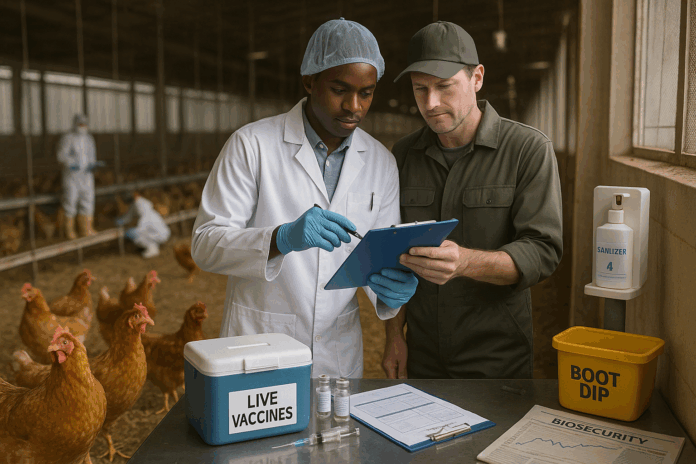Vaccination is the backbone of modern poultry farming, acting as both a shield and a strategic investment. Imagine losing over 50% of your flock to avian influenza or watching profits evaporate due to an outbreak—this isn’t a hypothetical scenario for many. Vaccines aren’t just about disease prevention; they’re about safeguarding livelihoods. When done right, they optimize flock health, reduce mortality, and ensure compliance with tightening global trade regulations. But here’s the catch: vaccines alone aren’t a magic bullet. They work best when paired with ironclad biosecurity and tailored management practices.
Consider the recent H5N1 outbreak in Brazil, which triggered international trade bans overnight. Or the $112 million loss in Minnesota’s turkey industry due to avian metapneumovirus. These aren’t just headlines—they’re wake-up calls. Vaccination is your insurance policy, but like any policy, its value depends on how well you understand the fine print. The goal isn’t just to inject birds; it’s to build resilience through precision, foresight, and collaboration between farmers and veterinarians.
Designing Effective Poultry Vaccination Schedules
Creating a vaccination schedule is like mapping a journey—you need to know the terrain. Start by assessing regional threats. Newcastle disease might dominate in Asia, while infectious laryngotracheitis (ILT) looms in the U.S. Southeast. Broilers, layers, and breeders each have unique needs. For instance, Marek’s disease vaccines are critical for layers but must be timed perfectly to avoid maternal antibody interference.
Vaccine choice matters. Live attenuated vaccines (like those for infectious bronchitis) mimic natural infection, triggering robust immunity but requiring careful handling. Inactivated vaccines offer longer protection but demand precise intramuscular administration. Then there’s route: spray vaccines cover large flocks quickly, but if 10–15% of birds are missed, immunity gaps invite disaster. Water-based delivery? Ensure water lines are free of sanitizers that kill live viruses.
Don’t forget boosters. Maternal antibodies from breeder hens can neutralize early vaccines, leaving chicks vulnerable. Delay the infectious bursal disease (IBD) vaccine until maternal antibodies wane, or risk leaving your flock defenseless.
Common Drug Mistakes Leading to Vaccine Failure
Mistakes here aren’t just costly—they’re deadly. Let’s break down the pitfalls:
- Storage Slip-Ups: Marek’s disease vaccines stored outside liquid nitrogen? Useless. Infectious bronchitis vaccines lose half their potency in warm temperatures within an hour. Always monitor cold chains.
- Admin Errors: Mass vaccination isn’t “set and forget.” Spraying vaccines unevenly or injecting into the wrong tissue (e.g., confusing ILT with fowl pox vaccines) leads to patchy immunity.
- Timing Blunders: Vaccinating stressed or sick birds? Their immune systems can’t respond. Worse, if birds are already incubating a disease, the vaccine arrives too late.
- Maternal Antibody Miscalculations: High antibody levels in breeders can block vaccine uptake in chicks. Test titers to time vaccinations accurately.
One grower’s mantra says it all: “Vaccines are no good if they don’t get into the chicken.”
Ensuring Supplier Reliability
Your vaccine supplier is your partner in survival. Here’s how to vet them:
- Strain Matching: Ensure vaccines target circulating strains. H5N1 clade 2.3.4.4b demands updated antigens, not outdated formulas.
- Cold Chain Transparency: Reputable suppliers track temperatures during transit. No logs? Walk away.
- Post-Sale Support: Reliable suppliers offer titer testing and troubleshoot failures. Avoid those pushing generic schedules.
Red flags? “One-size-fits-all” solutions and lack of documentation. Remember, a cheap vaccine that fails costs more than a premium one that works.
Managing Disease Outbreaks in Vaccinated Flocks
When outbreaks strike, speed and precision save flocks. Start with surveillance: ELISA tests can detect antibody gaps before symptoms appear. Notice “rolling reactions” (prolonged mild illness)? That’s a sign of vaccine failure.
Lock down biosecurity: disinfect equipment, restrict farm access, and isolate sick birds. In Brazil’s H5N1 outbreak, zoos closed and farms quarantined within hours. For emergencies, revaccinate with killed vaccines to boost immunity fast.
Case Studies & Lessons Learned
- Success: A U.S. hatchery achieved 100% protection using automated in-ovo IBD vaccination. Key? Precision and avoiding human error.
- Failure: Live ILT vaccines in the Southeast U.S. spawned virulent strains, costing millions. Lesson? Choose vaccines wisely—sometimes live isn’t better.
Tools & Resources
- Checklists: Track storage temps, expiry dates, and equipment calibration.
- Sample Schedules: Tailor timelines for broilers (short-term) vs. layers (long-term).
- Supplier Qs: Ask about adjuvants, DOI data, and strain updates.
Future Trends
The future is precision: AI monitors flock health in real-time, while recombinant vaccines target mutations. Yet, tech alone won’t suffice. Farmers and vets must collaborate—audit practices, share data, and adapt. As H5N1 evolves and trade barriers rise, your best defense is a proactive, informed strategy.
Key Takeaways
- Customize schedules—no two farms are alike.
- Audit suppliers like your profits depend on it (they do).
- Train teams relentlessly; 15% missed birds = 15% risk.
- Biosecurity + vaccines = layered defense.
- Embrace innovation but trust proven science.
Your flock’s health isn’t just a duty—it’s a legacy. Act wisely.


